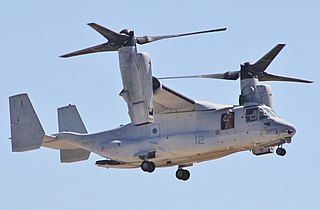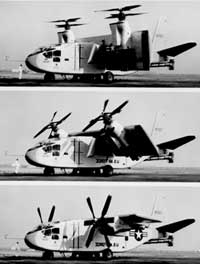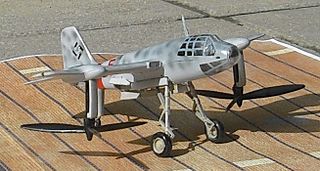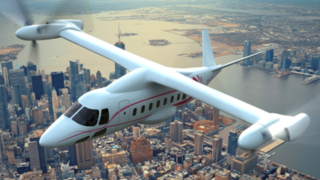A vertical take-off and landing (VTOL) aircraft is one that can take off and land vertically without relying on a runway. This classification can include a variety of types of aircraft including helicopters as well as thrust-vectoring fixed-wing aircraft and other hybrid aircraft with powered rotors such as cyclogyros/cyclocopters and gyrodynes.

The Bell Boeing V-22 Osprey is an American multi-mission, tiltrotor military aircraft with both vertical takeoff and landing (VTOL) and short takeoff and landing (STOL) capabilities. It is designed to combine the functionality of a conventional helicopter with the long-range, high-speed cruise performance of a turboprop aircraft.

A tiltrotor is an aircraft that generates lift and propulsion by way of one or more powered rotors mounted on rotating shafts or nacelles usually at the ends of a fixed wing. Almost all tiltrotors use a transverse rotor design, with a few exceptions that use other multirotor layouts.

The Bell XV-15 is an American tiltrotor VTOL aircraft. It was the second successful experimental tiltrotor aircraft and the first to demonstrate the concept's high speed performance relative to conventional helicopters.

A tiltwing aircraft features a wing that is horizontal for conventional forward flight and rotates up for vertical takeoff and landing. It is similar to the tiltrotor design where only the propeller and engine rotate. Tiltwing aircraft are typically fully capable of VTOL operations.

The AgustaWestlandAW609, formerly the Bell/Agusta BA609, is a twin-engined tiltrotor VTOL aircraft with a configuration similar to that of the Bell Boeing V-22 Osprey. It is capable of landing vertically like a helicopter while having a range and speed in excess of conventional rotorcraft. The AW609 is aimed at the civil aviation market, in particular VIP customers and offshore oil and gas operators.

The Bell Helicopter Eagle Eye, Model 918, was an American tiltrotor unmanned aerial vehicle that was offered as one of the competitors in the United States Navy's VT-UAV program.

The Curtiss-Wright X-19, company designation Model 200, was an American experimental tiltrotor aircraft of the early 1960s. It was noteworthy for being the last aircraft of any kind manufactured by Curtiss-Wright.

The Bell XV-3 is an American tiltrotor aircraft developed by Bell Helicopter for a joint research program between the United States Air Force and the United States Army in order to explore convertiplane technologies. The XV-3 featured an engine mounted in the fuselage with driveshafts transferring power to two-bladed rotor assemblies mounted on the wingtips. The wingtip rotor assemblies were mounted to tilt 90 degrees from vertical to horizontal, designed to allow the XV-3 to take off and land like a helicopter but fly at faster airspeeds, similar to a conventional fixed-wing aircraft.

The Bell Boeing Quad TiltRotor (QTR) is a proposed four-rotor derivative of the Bell Boeing V-22 Osprey developed jointly by Bell Helicopter and Boeing. The concept is a contender in the U.S. Army's Joint Heavy Lift program. It would have a cargo capacity roughly equivalent to the C-130 Hercules, cruise at 250 knots, and land at unimproved sites vertically like a helicopter.

In fluid dynamics, disk loading or disc loading is the average pressure change across an actuator disk, such as an airscrew. Airscrews with a relatively low disk loading are typically called rotors, including helicopter main rotors and tail rotors; propellers typically have a higher disk loading. The V-22 Osprey tiltrotor aircraft has a high disk loading relative to a helicopter in the hover mode, but a relatively low disk loading in fixed-wing mode compared to a turboprop aircraft.

The Westland Westminster was a British helicopter of the 1950s from Westland Aircraft. A large cargo design, it was powered by two turboshaft engines driving a single, five-bladed rotor. Initially unclad, the all-metal airframe was later enclosed in a fabric covering. Designed and built as a private venture without government assistance, it was cancelled when Westland took over rival helicopter producers and their more advanced projects.

The Percival P.74 was a British experimental helicopter designed in the 1950s that was based on the use of tip-jet powered rotors. Although innovative, the tip-rotor concept literally failed to get off the ground in the P.74, doomed by its inadequate power source. Rather than being modified, the P.74 was towed off the airfield and scrapped.

A proprotor is a spinning airfoil that function as both an airplane-style propeller and a helicopter-style rotor. Several proprotor-equipped convertiplanes, such as the Bell Boeing V-22 Osprey tiltrotor, are capable of switching back and forth between flying akin to both helicopters and fixed-wing aircraft. Accordingly this type of airfoil has been predominantly applied to vertical takeoff and landing (VTOL) aircraft.

The Focke-Achgelis Fa 269 was a tiltrotor VTOL aircraft project designed by Henrich Focke.

Kenneth Gene Wernicke was an American aerospace engineer. He had a leading role in the development of the tilt rotor aircraft Bell XV-3, Bell XV-15 and V-22 Osprey.

The AgustaWestland Project Zero is a hybrid tiltrotor/Lift fan aircraft. It has been developed by AgustaWestland as a technology demonstrator, and is used to investigate all-electric propulsion and other advanced technologies. It is the world's first electric tiltrotor aircraft.

The Kayaba Heliplane Type-1 was a gyrodyne designed by Shiro Kayaba and prototyped by Kayaba Industry in Japan during the early 1950s.

The Leonardo Next-Generation Civil Tiltrotor is a tiltrotor aircraft demonstrator designed and developed by the Italian aerospace company Leonardo S.p.A. Studies for a two times larger tiltrotor than the AgustaWestland AW609 started in 2000. Since 2014, its development is sponsored by the European Union's Clean Sky 2 program. By May 2021, major components were under production By 2023, the maiden flight had been pushed back to 2024, from a 2020 initial plan.


















